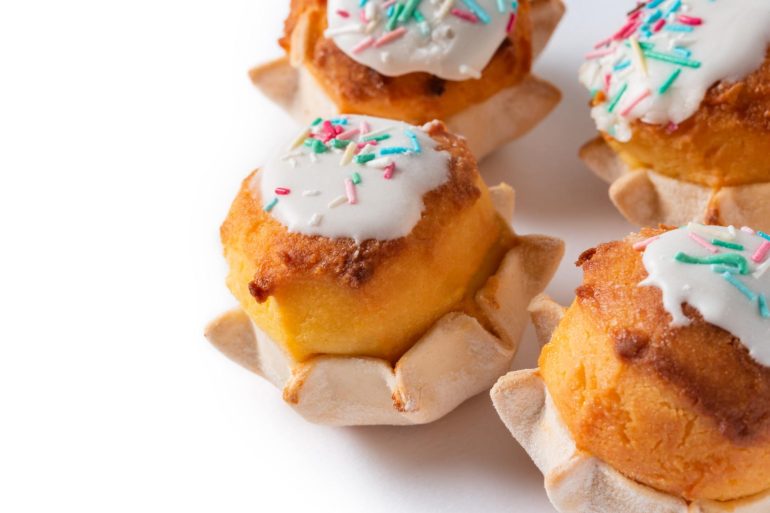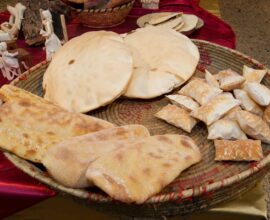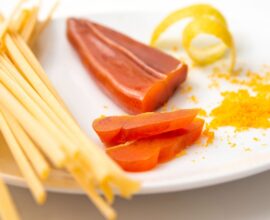Foodie Easter: history and flavours of the Sardinian table
The Sardinian table’s typical flavours for Easter
A culinary journey to discover the dishes that enrich the Sardinian table on the Easter holidays.
Sardinia boasts a thousand-year history and strong traditions that are also reflected during the Easter holidays when, the engaging rites of Holy Week, are accompanied by the typical flavours and aromas.
Many dishes relate to Easter in Sardinia, one of the most heartfelt festivals on the island, and vary not only between the coast and the hinterland but, often, also from village to village.
From ritual breads to the classic lamb to the rich desserts, here are some of the goodness that cannot miss on the Sardinian Easter Table.
The delicious gastronomic Easter in Sardinia
As mentioned, Easter is a very important holiday for the island, known as “Sa Pasca Manna”, during which solemn religious rites are combined with customs, traditions and popular folklore.
And such a special period cannot fail to be characterised by unique dishes and recipes, all to be enjoyed together.
Let’s start with the essential food, bread: the pride of Sardinia is the art of baking and the preparation of bread linked to specific occasions.
For Easter, here is “Su coccoi”, durum wheat semolina bread of various sizes and shapes, finished with precious decorations and an egg at its centre.
Depending on the manual skills of the baker, it can take on different embroideries and shapes, until it becomes a real “work of culinary art”.
On Palm Sunday children are given “Sa Pippia”, a small doll of bread with seven legs, a sort of “Advent calendar” for Easter.
Every day, in fact, the little ones detach a leg and thus realise how many days are missing to the holy day.
Another great classic is the “Panada”, a basket of bread in which food is cooked as in a pot.
For Easter, the “Panada” is prepared with lamb and artichokes: the lamb is stewed while, separately, the artichokes are cut into strips and then sautéed in a pan with parsley, garlic and a splash of white wine.
The bread is made from lard, re-milled semolina, water and salt. As soon as the dough is ready, it is given the shape of a pot in which to place the ingredients and cover everything with a carefully sewn lid of bread. It is then baked until the dough appears golden.
Among the typical meats for the Easter period, we find kid lamb, roasted in the fireplace or on the spit, and the Sardinian IGP lamb, a true symbol of Easter, prepared according to tasty culinary ideas: stewed, stewed with garlic, parsley and wild thistles, baked with potatoes or fresh sheep’s cheese.
Again, a dish based on lamb that recalls the concept of sharing and family is “sa tratalia”: the spleen, liver, heart and lung of the lamb are cut and alternated on the spit.
They leave the heart for an hour on the grill and, then, wrap it first with the “nappa”, a net of fat, then with the intestine of the animal, completing the cooking for another half hour until the meat is golden.
It is served taking care that each diner receives at least a part of each ingredient.
Finally, among the desserts stand out the “Casadinas” or “Pardulas”, and the “Formagelle”, prepared throughout the island, with local variations. Of soft consistency and round shape, they are composed of a basket with raised edges, as if it were a star, worked with lard paste. The main ingredient for the filling is ricotta or fresh cheese with the addition of aromas such as saffron and orange or, in some areas, raisins.
Other delicacies are the crunchy almonds (the “Gattò”), the ” Piricchitus”, simple lemon desserts, the “Papassinas”, from a dough of flour, eggs, raisins, lard, chopped walnuts and/or almonds, and, in Gallura and Logudoro, the “Tiliccas”, sweets of various shapes stuffed with must.
All the flavours of the Sardinian Easter at Forte Village
A holiday in Sardinia during Easter weekend and Easter Monday can be the ideal time to taste in person the authentic flavours of traditional dishes and discover the island from a gastronomic point of view.
Precisely for this reason, Forte Village Resort, a prestigious luxury resort in Santa Margherita di Pula in the province of Cagliari, has created an exclusive holiday package for those who want to spend pleasant days savouring a sumptuous menu with rich local, Italian and international selections.
The award-winning resort boasts, in fact, a wide range of gourmet restaurants that know how to satisfy all palates and give an absolute sensory experience to every bite.
In the fabulous setting of the white beach lapped by the crystal-clear sea of Sardinia, guests can be delighted by the delicacies of the best Italian and international chefs prepared with the best raw materials, in a perfect balance between tradition, innovation and experimentation.
Would you like to taste the unique flavours of Sardinian Easter dishes and experience a fabulous holiday in an authentic paradise? Discover Forte Village Resort in Sardinia






